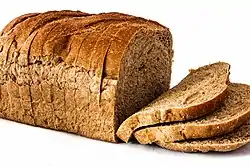| Type | Bread |
|---|---|
| Place of origin | Medieval Europe |
| Main ingredients | Legumes, grains, nuts, roots |
| Horsebread Act 1540 | |
|---|---|
| Act of Parliament | |
.svg.png.webp) | |
| Long title | An Act concerning baking of Horse-bread. |
| Citation | 32 Hen. 8. c. 41 |
| Dates | |
| Royal assent | 24 July 1540 |
| Horsebread Act 1623 | |
|---|---|
| Act of Parliament | |
.svg.png.webp) | |
| Long title | An Act concerning Hostlers and Inn-holders. |
| Citation | 21 Jas. 1. c. 21 |
| Dates | |
| Royal assent | 29 May 1624 |
Horsebread was a type of bread produced and consumed in medieval Europe. At the time, it was considered to be of low quality, made from a seasonal mix of legumes (such as dry split peas) and bran[1] along with other non-wheat cereal grains such as oats, rye, and acorns. It was one of the cheapest breads available.
As the name suggests, it was primarily used as a feed supplement for horses, being more compact and easier to digest than bulkier feed like hay.[2] Horsebread was given to work horses to help them recover, and special horsebread recipes were developed for race horses as part of their training.[2]
During times of siege or famine, the less-expensive horsebread could sustain the population, and was consumed by the very poor "even in times of plenty".[2][3] It was associated with poverty, since those who could afford white bread (which was the most labour-intensive, and therefore expensive, bread) considered horse bread and other breads like rye or barley breads unfit for their position in society.[4]
White breads were generally eaten by only the middle class and wealthy, because of the labour involved in refining flour. This is in contrast with modern whole-grain breads, which are typically seen as premium-priced health foods or gourmet foods. This is in part because modern flour has a higher gluten content than flour produced in medieval Europe, so bread made from less-refined flour is more palatable than it would have been during the Middle Ages.[5]
See also
- Brown bread – another European bread that was originally considered undesirable
- Polenta – as a staple food of the poor in early modern northern Italy
- Sprouted bread
- Whole wheat bread
References
- ↑ Hanawalt, Barbara (26 June 2017). Ceremony and Civility: Civic Culture in Late Medieval London. Oxford University Press. p. 95. ISBN 978-0-19-049039-3. Retrieved 3 August 2022 – via Google Books.
- 1 2 3 Rubel, William (2006). "English Horse-bread, 1590–1800". Gastronomica. 6 (3): 40–51. doi:10.1525/gfc.2006.6.3.40. ISSN 1529-3262.
- ↑ Lin-Sommer, Sam (22 July 2022). "For Centuries, English Bakers' Biggest Customers Were Horses". Atlas Obscura. Retrieved 3 August 2022.
- ↑ Davis, James (22 November 2005). "Baking for the common good: a reassessment of the assize of bread in Medieval England". The Economic History Review. 57 (3): 465–502. doi:10.1111/j.1468-0289.2004.00285.x. ISSN 0013-0117. S2CID 154643188.
- ↑ Sim, Alison (1996). The Tudor Housewife. Glouchestershire: Sutton Publishing Limited. p. 11. ISBN 978-0-7735-2233-6.
External links
- Mediaeval Horsebread. Elizabeth's Kitchen Diary.
- For Centuries, English Bakers’ Biggest Customers Were Horses. Atlas Obscura.
